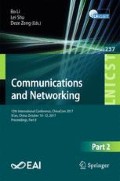Abstract
In this paper, we deliberate on multiuser massive multiple-input multiple-output (MU-MIMO) system in designing optimal zero forcing (ZF) precoder under per antenna power constraint. MU massive MIMO with non-square matrix is restrained by the large channel matrix dimension, conjugate beamforming maximization approach is developed to align the channel matrix for the optimal ZF precoder. We further introduced complex lattice reduction (CLR) to transform the lattice bases of the channel matrix and shorten the basis vector, thus meliorates the orthogonality of the conjugate beamforming. Simulation results show LR-based optimal ZF precoder outperforms other precoding schemas. The LR-based optimal ZF precoder improved the beamforming for the base station (BS) to focus on the users, thus improving spatial multiplexing gain and diversity order. As BS antennas and users turn large, the sum rate over the subchannels depends on the dominance of users (that is BS antennas to user antennas ratio) for the channel gain. Thus performance of the LR-based precoder schema under per antenna power can help save power in practical massive MIMO implementation.
Access this chapter
Tax calculation will be finalised at checkout
Purchases are for personal use only
Notes
- 1.
For \(\mathbf {T}_{n}=\left[ \mathbf {\bar{V}_{1}\hat{V}}_{1},\mathbf {\bar{V} _{2}\hat{V}}_{2},\ldots \mathbf {\bar{V}_{N}\hat{V}}_{N}\right] \)as the transmit power constraint (2) is formulated in \(\mathbf {tr} \left( \mathbf {\bar{V}_{n}\hat{V}}_{n}\mathbf {\hat{V}}_{n}^{\mathrm {H} }\mathbf {\bar{V}}_{n}^{\mathrm {H}}\right) \) for the power constraint.
- 2.
The basis vectors are multiplied by square vector and determinant of \(\pm 1\), the elements are complex integer entries \(\kappa _{n}^{u}\).
- 3.
The orthogonality defect is used to measure the orthogonality basis vectors, formed by all the inner products as \(\frac{\prod \nolimits _{i=1} ^{n}\left\| \mathbf {\breve{x}}_{i}\right\| }{\left\| \mathbf {\breve{X}}_{n}^{\mathrm {\dag }}\right\| ^{2}}\).
References
Rusek, F., Person, D., Lau, B.K., Larsson, E.G., Marzetta, T.L.: Scaling up MIMO: opportunities and challenges with very large arrays. IEEE Sig. Proc. Mag. 30, 40–60 (2013)
Ngo, H.Q., Larsson, E.G., Marzetta, T.L.: Energy and spectral efficiency of very large MU MIMO systems. IEEE Trans. Commun 61(4), 1436–1449 (2013)
Zu, K., Lamare, R.C.: Low - complexity lattice reduction-aided regularized block diagonalization for MU-MIMO system. IEEE Commun. Lett. 16(6), 925–928 (2012)
Serbetli, S., Yener, A.: Transceiver optimization for multiuser MIMO systems. IEEE Trans. Sig. Process. 52(1), 214–226 (2004)
Yao, R., Nan, H., Xu, J., Li, G.: Optimal BD-ZF precoder for multi-user MIMO downlink transmission. Electron. Lett. 51(14), 1121–1123 (2015)
Luo, Z.Q., Yu, W.: An introduction to convex optimization for communications and signal processing. IEEE J. Sel. Areas Commun. 24(8), 1426–1438 (2006)
Boyed, S., Vandenerghe, L.: Convex Optimization. Cambridge University Press, Cambridge (2004)
Perez-Cruz, F., Rodrigues, M.R.D., Verdu, S.: MIMO Guassian channel with arbitrary inputs: optimal precoding and power allocation. IEEE Trans. Inf. Theory 56(3), 1070–1083 (2010)
Kaviani, S., Krzymien, W.A.: On the optimality of multiuser ZF precoding in MIMO broadcast channels. In: IEEE VTC Spring (2009)
Vu, M.: MISO capacity with per-antenna power constraint. IEEE Trans. Commun. 59(5), 1268–1274 (2011)
Zu, K., Song, B., Haardt, M., Lamare R.C.: Flexible coordinated beamforming with lattice reduction for MU massive MIMO systems. In: IEEE EUSIPCO (2014)
Lutkepohl, H.: Handbook of Matrices. Wiley, Hoboken (1996)
Bremner, M.R.: Lattice Basis Reduction: An Introduction to the LLL Algorithm and Its Applications. Taylor & Francis Group, London (2012)
Author information
Authors and Affiliations
Corresponding author
Editor information
Editors and Affiliations
Rights and permissions
Copyright information
© 2018 ICST Institute for Computer Sciences, Social Informatics and Telecommunications Engineering
About this paper
Cite this paper
Nyarko, J.K.N., Mbom, C.A. (2018). Optimal ZF Precoder Under per Antenna Power with Conjugate Beamforming for MU Massive MIMO Systems. In: Li, B., Shu, L., Zeng, D. (eds) Communications and Networking. ChinaCom 2017. Lecture Notes of the Institute for Computer Sciences, Social Informatics and Telecommunications Engineering, vol 237. Springer, Cham. https://doi.org/10.1007/978-3-319-78139-6_20
Download citation
DOI: https://doi.org/10.1007/978-3-319-78139-6_20
Published:
Publisher Name: Springer, Cham
Print ISBN: 978-3-319-78138-9
Online ISBN: 978-3-319-78139-6
eBook Packages: Computer ScienceComputer Science (R0)

